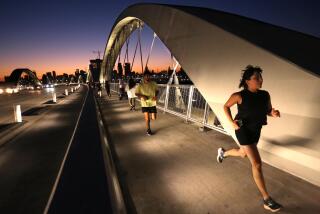Outrigger Canoe Club Takes to the Waves : Recreation: Eighteen Southern California crews race each other during the summer. Men, women work together on Hokuloa team.
- Share via
VENTURA — Just before sunset, three canoes slice through the still water in the Ventura Keys like torpedoes, leaving only tiny ripples in their wake.
In perfect sync, the crew members on each boat stab the water with wooden paddles, powering the canoes through the narrow channels at nearly 7 knots. Except for an occasional cry of “Hut!”--the command to switch paddle sides--the paddlers are silent. When their arms move like angry pistons, it’s too hard to speak.
“Ready, Kim, let’s turn it,” says 42-year-old steersman Laura Byrd, calling to Kim Saito at the front of the six-person canoe. “Do a right turn.”
Three times a week after work, about 20 women and 10 men hoist 400-pound outrigger canoes onto carts and roll them down the beach near the Channel Islands National Park Headquarters in Ventura Harbor.
Like the ancient Polynesians before them, members of Hokuloa Outrigger Canoe Club travel the ocean in a canoe attached to a float--a banana-shaped pontoon that keeps the hull from tipping.
“The ocean, the breeze, the waves, the workout and the action,” said Byrd, a vice president of an electrical contracting company and a Ventura resident, describing the sport’s appeal. “Most sculling is usually on flat water.”
Outrigger canoeing first caught on in Ventura County in 1976. But the first club in Oxnard dissolved three years later. During the late 1970s and early ‘80s, several outrigger canoe clubs died and were resurrected in Ventura County.
Hokuloa formed in 1987 when outrigger canoeing started gaining popularity as a sport in California. Today, 18 clubs in Southern California from San Diego to Santa Barbara belong to the Kalifornia Outrigger Assn. and race each other during the summer.
Though Hokuloa has fielded men’s and women’s teams, this year the club does not have an organized men’s crew. Men and women practice in the same boat, but they compete separately.
“It’s a really good upper-body workout,” said Hokuloa’s president, Ann Thompson, 34, a registered dietitian from Ventura. “People who are water-oriented--surfers, kayakers, swimmers--are all into it because you are out on the ocean competing.”
Last week, the paddlers spent most of their grueling, two-hour practices working on sprints in the harbor to prepare for this weekend’s state championships in Santa Barbara. On Aug. 19, the club will host the 1995 Ventura Channel Challenge--a 20-mile race around Ventura Harbor. But many paddlers have set their sights on the 24th annual Queen Liliuokalani Outrigger Canoe Race in Hawaii on Sept. 2.
“We’re hoping to come in in the top 20,” Thompson said. “There are 60 canoes in that race.”
But on water, the paddlers are not thinking about placing. They are just thinking about surviving the workout.
“That’s your bartender, Ona, up front,” says Byrd, adding a little levity to a tough practice as she points to 42-year-old crew member, Ona Shiroyama of Ventura.
Hokuloa’s informal coach, Phil Gumbert, 37, has just announced that they will paddle another six-minute “piece.”
“Let’s line them up!” barks Gumbert, a Camarillo resident and one of only four men practicing this day. “Paddle!”
Like expertly programmed robots, the women sit single-file in a hull barely wider than a phone book and begin paddling in perfect unison. The canoe cuts through a patch of choppy water as it glides toward Ventura Harbor.
“It’s a lot harder than it looks,” says Shiroyama, an optometrist when she’s land-bound. “You’re using not only your arm but your whole body.”
Polynesians crossed thousands of miles of the Pacific in 60-foot outrigger canoes made of koa wood. They used smaller ones to fish, travel to different islands and race.
Though Hokuloa’s canoes are fiberglass and measure about 40 feet, steersman Gary Lee says outrigger canoe racing is a way to get back to his roots.
“It’s a heritage thing,” says Lee, 49, a Honolulu native who lives in Ventura. “This is an extension of my cultural background. It’s the only team sport I participate in.”
When the canoes reach the shore at Marina Cove Beach, the paddlers hop out into ankle-deep water and slap high-fives.
“It was good,” says Shiroyama as she helps lift the canoe onto its cart.
The others agree. One calls out from the group:
“It’s women against the sea!”
More to Read
Sign up for The Wild
We’ll help you find the best places to hike, bike and run, as well as the perfect silent spots for meditation and yoga.
You may occasionally receive promotional content from the Los Angeles Times.






